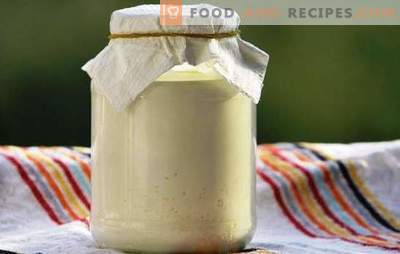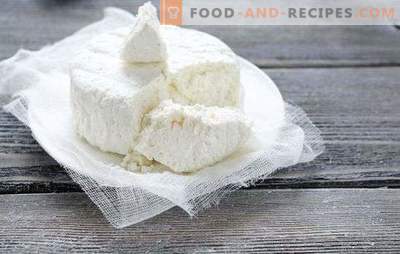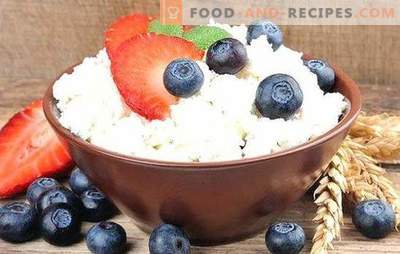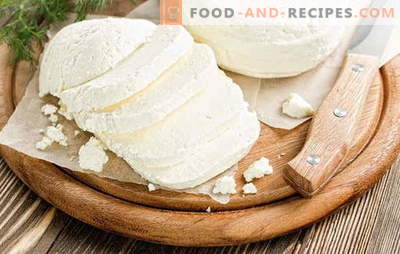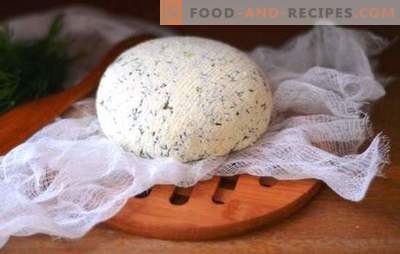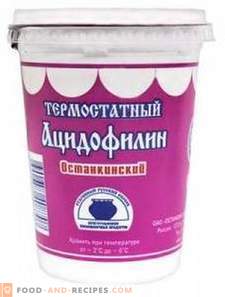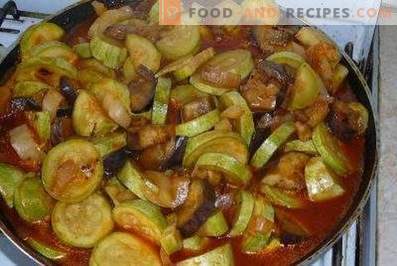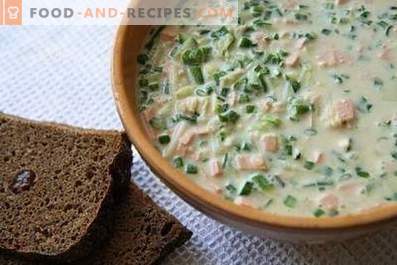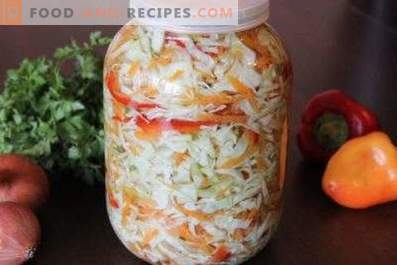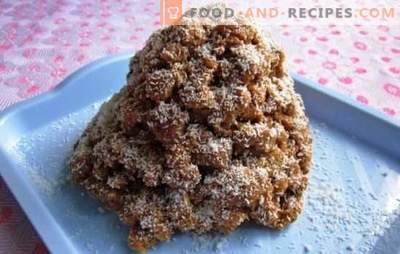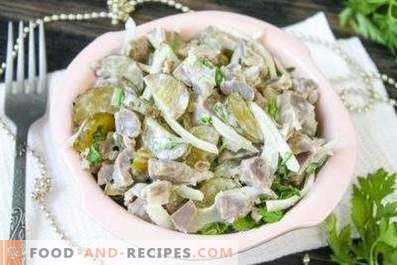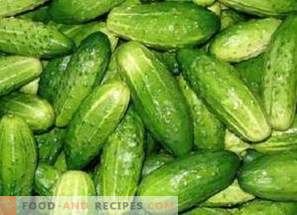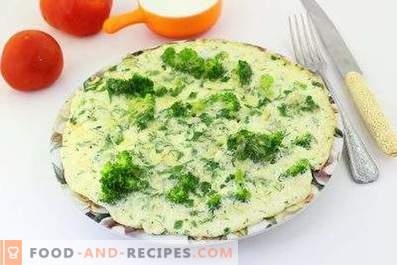in the morning
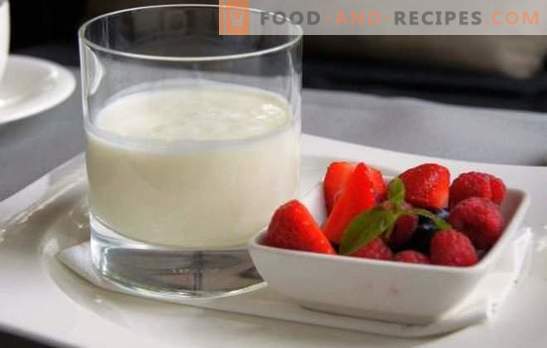
All fermented milk products were once only domesticated, since the dairy industry appeared, figuratively speaking, yesterday, and humans tamed animals that give milk more than ten thousand years ago.
Since then, it was at home that people learned to make different products from ordinary milk.
Progress and urbanization have taken humanity away from its origins, where it was possible to live in harmony with nature, eat natural, organic products, and at the same time, in case of health problems, be treated by nature.
Interesting about homemade milk yogurt
The history of kefir in Russia and in Eastern Europe looks like a beautiful fairy tale - at the beginning, and in the second part there are even two versions of the leakage of the recipe for a secret Caucasian drink of the same name.
Highlanders believe in the legend that they got the recipe for home-made kefir from milk from the Prophet Mohammed himself, along with the mysterious “yellow balls” that had to be added to the drink. The great prophet ordered not to reveal the secret of the “grains” to the Gentiles. But, as one of the versions of the appearance of kefir in Russia, one Chechen, nevertheless, gave a secret along with kefir fungi to his friend, a Russian doctor, who visited the Caucasus. It was in 1886.
Another version, directly, as in the famous comedy about a Caucasian prisoner, talks about the abduction of a beautiful girl. Only the abduction was double - oh, these mountaineers! After her safe release, as compensation for moral damage, the young assistant of the Russian dairy Blandova received the cherished “grains of Mahomet”, for whom she, in fact, went on a trip to the Caucasus. The story did not end as romantic as it began, but in 1908 kefir “went to the people”, thanks to the practicality and business qualities of an adventurer. Apparently, the kefir fungi donated to the doctor were spent on scientific experiments and the study of microorganisms, because the society of Russian doctors asked the dairy factory to start mass production of kefir, which Blandov fulfilled, thanks to the beauty of her assistant Irina Sakharova. It is not known which version is genuine, but the word “kefir” phonetically absolutely exactly coincides with the name of this drink in the language of the peoples of Ossetia. It would be much more interesting to find out about the “grains” donated by Mahomet: were they exactly the ones that are now used to make kefir; or maybe the whole thing is that the mountaineers kept their milk in bags made from the skins of animals, and from this it acquired such a peculiar taste after souring the milk? But why then, after the skins were replaced by earthen jars, the taste of Caucasian kefir remained the same? Why sour milk, in the same jugs, the hostesses of the Little Russian province, the Don Cossacks and other owners of pottery did not become kefir in the nineteenth century, and so were still yogurt?
Home-made kefir from milk - an ideal formula for storage and benefits
Of course, it would be foolish to completely abandon the achievements of science and technical progress, but the trouble is that often modern manufacturers of products, unlike Blandow, forget that you won’t make all the money, even using the latest developments in the food industry, because from the thirst for profit is lost quality and consumer confidence.
The addition of preservatives to increase shelf life makes kefir useless and sometimes even harmful. For example, fermented milk bacteria in canned form is nonsense. What benefits can they bring to digestion when they are dead? But the dairy plant, “putting the microorganisms aside” of the “live” milk with additives, ultrapasteurization and other industrial “tricks” will not be lost - the plastic bottle of kefir can safely stand on the shelf of the shop window for a month until it is bought in a hurry or due to ignorance of the city man in the street, not versed in matters of dairy technology and healthy nutrition. Sensible people and nutritionists understand that such a product is worthless, because it is useless biomass in an expensive package, and not a source of beneficial bacteria and vitamins for the body. Anything can be written on the packaging, but the product itself is not visible under plastic and, even visually, one cannot judge its quality until you bring it home and print it out. Naturally, protecting, first of all, their health, each person is looking for an alternative. If we approach the issue from the side of saving the family budget, it is easy to calculate that a half-liter bottle of full-fledged home-made kefir from milk costs at least two times less than the same volume of product from the best manufacturer, and even with retail mark-ups networks, advertising and transport logistics managers.
For the sake of justice, it should be noted, that it is not every day you want to go to the store for fresh kefir, when after work you fall down from your feet for fatigue or rush, or just forget. Therefore, although you know that only the freshest kefir is actually useful, you drink one that has remained from yesterday or the day before yesterday in a printed bottle in the refrigerator.
Interest in the composition of kefir is caused precisely by a set of microorganisms, thanks to which the drink has gained wide popularity not only as a product - it is widely used in dietology and medical nutrition.
Barely appearing in Europe, kefir attracted the attention of microbiologists, who carefully studied its probiotic properties - the effect of microorganisms on the intestinal microflora and their participation in metabolism. The especial taste of kefir is formed by the Bulgarian wand, named after its discoverer, the young Bulgarian scientist Stamen Grigorov, who lived in the nineteenth century, a contemporary of the Russian Nobel Prize winner Ilya Mechnikov, who dedicated his work to the study of lactic acid bacteria and propagandized the use of probiotics among his campaign articles, which was part of the article, which was used in the article, which contributed to the study of lactic acid bacteria and promoted the use of probiotics in the article, which was used in the article, which was used in the article, which was used in the article.
Bacteria, like any living organisms, require certain conditions for normal functioning - oxygen, nutrients, temperature. In the absence of one of these conditions, the bacteria die. In order not to overload readers with purely scientific information, let us pay attention to the main points that must be taken into account when buying, storing or making home-made kefir from milk.
The temperature required for fermentation of milk, at the time when the bacteria multiply in the dairy environment, and its fermentation takes place, must be not lower than 18 ° C and not higher than 23 ° C. At the same time, bacteria need oxygen, therefore, when fermenting milk, the dishes are not tightly closed, but only protect the mass from ingress of impurities and harmful microorganisms. Bacteria feed in abundance of milk, which contains the full range of necessary substances for their vital activity. After the milk is completely processed and turned into kefir, the growth and multiplication of bacteria must be stopped. For this, the finished drink is placed in a cooler place. At a temperature of 2-6 ° C, microorganisms fall into a state of suspended animation, when they do not need oxygen or food. Fresh, one-day kefir has the highest quality and useful, healing properties. Long-term storage turns kefir into a regular, fermented milk drink, with an increased level of acidity, and not always a pleasant taste. After 72 hours from the moment of production, unused kefir can be used, perhaps, for preparing dough, since its biological value is lost. The high level of acidity, which is achieved by this time, may already adversely affect digestion, while in dough, in combination with baking powder, kefir helps to ensure lifting and cook lush baking.
Home-made kefir from milk - healthy and healthy food made by human hands, rather than conveyor lines of modern production, is increasingly returning to its former positions, and proof of this is the regular search for information about home technologies, forgotten recipes for home-made kefir from milk. Having obtained the necessary information about the technology of dairy products in our own kitchen, having trained and mastered the simple skills of making home-made kefir from milk, you can solve all the problems at once - with a family budget, saving time and taking care of health.
Homemade kefir from milk: microorganisms work - do not interfere with them!
If with cottage cheese, sour cream and yogurt - everything is simple, then for home-made kefir from the milk of ordinary one-component ferment is not enough. All the answers to the questions about the peculiar taste of kefir are revealed by bacteriology, which studied the interaction of microorganisms in the dairy environment. They are present in our lives everywhere, not only in the skins and jugs. To know which microorganisms are part of the bacterial starter, you need not only to make home-made kefir from milk - its storage and use will be more effective in combination with an understanding of the composition of the fermented milk drink.
Sour milk, sour cream and cottage cheese are the result of fermented milk fermentation, when milk sticks and cocci (balls) get into milk - simple, single-cell microorganisms, which form lactic acid as a result of their vital activity. In an acidic environment, the coagulation of casein (milk protein) occurs and whey is formed. But in kefir, in addition to lactic acid, there is a gas that tastes with a slight tingling on the tongue. This is because milk contains lactose, milk sugar, and any sugar is a favorable medium for alcoholic yeast, another group of microorganisms. Moreover, lactic bacteria and alcoholic yeast peacefully coexist with each other, and even help: lactic acid bacteria, forming lactic acid, contribute to the release of milk sugar, which is necessary for alcoholic yeast. Now it becomes clear why kefir appeared in a jug in the Caucasus, and not in Russia: the mild mountain climate of the Caucasus with developed viticulture and winemaking, wine that was also traditionally stored in waterskins and jugs - a few drops of young the wine could well remain at the bottom of the vessel, and the wine is the wine yeast. Milk was poured into a jug or wine sack, and a sour-milk drink with a light, intoxicating flavor was born by chance. After all, kefir contains up to 1% alcohol, and koumiss and some other types of kefir contain up to 3%.
As you can see, the whole technology of making home-made kefir from milk is to put bacteria and yeast into milk, create a comfortable microclimate for them, and they will do the rest of the work themselves.
Homemade kefir from milk - how to choose and keep the leaven
Let us turn to the question of yeast for kefir. Here it is necessary to dwell in detail on the question of what constitutes a true kefir starter. As mentioned above, the Bulgarian wand must necessarily be included in its composition. Also, the presence of acidophilus sticks, thermophilic streptococci, and bacteria involved in the synthesis of riboflavin is required - a total of 8 species of bacteria. To memorize them, not even knowing the basics of bacteriology, is a difficult task, so you just need to know that without these microorganisms, neither taste nor the properties of real kefir can be obtained.
There are two simple options for obtaining it: to buy ready-made mixture in a specialized trading network or to spend money once on a bottle of kefir, where the composition of the product will be written on the label and honestly.
Of the dry sourdoughs, the best option is VIVO. If this mixture is difficult to get, go to the dairy kitchen for babies - there buy a glass bottle with the freshest kefir, just remember to leave 250 ml of cooked homemade kefir from milk to add it to prepare the next batch of drink. It is better not to try to find sufficiently active microorganisms in a film or plastic bottle - it will turn out, at best, tasty sour milk. But there is a third option - use wine yeast in combination with any fermented milk bacteria and grow a microorganism colony, which will become helpers in preparing their own, home-made kefir from milk, if you decide that an environmentally friendly and fresh product is needed in house constantly. Of course, the identical taste is not guaranteed, but you can be sure that you get a useful symbiosis from lactic acid bacteria and yeast.
Homemade milk kefir - raw materials and the sequence of preparation of the beverage
For kefir use any, both fresh and pasteurized milk - cow, goat, camel, mare, buffalo. True, the composition of each of these types of milk has a difference. Accordingly, mare's milk is produced by koumiss. Ayran is prepared from goat, sheep, and by adding spicy herbal infusions, salt - tan. The range of fermented milk drinks, identical to kefir, is not exhausted in the kitchens of different nations.
In industrial conditions, milk for kefir is pasteurized. UHT milk and sterilized milk does not contain any bacteria and vitamins. At a pasteurization temperature of 63 ° C, not only harmful microorganisms but also lactobacilli die within 30 minutes, and for Bulgarian rods the critical temperature is even lower, 50 ° C. At a temperature of 80-85 ° C, pasteurization lasts 10 minutes, and at 90-93 ° C milk is pasteurized for 2-3 minutes. At 100 ° C, the texture of the milk is broken, and it becomes unsuitable for the formation of a clot during souring.
In industrial conditions between pasteurization and the introduction of starter culture, there is an intermediate stage - the homogenization of milk. The essence of this process is to break the fat globules in order to create a homogeneous mass with the necessary consistency. At this stage, the milk is distilled under pressure in another tank. For home technology, you can skip this operation or use a blender (mixer) to mix milk.
The next step is making kefir starter. After cooling to 18-23 ° C, kefir starter is introduced into the milk purified from pathogenic organisms. The leaven is presoaked in water at a temperature of 28-30 ° C for 24 hours, and at the same time water is changed every 8 hours. After swelling of the starter, it is added to the prepared milk. The ratio of the volume of the added starter and milk is 1:10. That is, the prepared starter is 100 ml per liter of milk. Milk with sourdough is mixed for 20-30 minutes, and then left to ripen, no longer touching it. When cooled and matured, kefir is aged 10-12 hours at a temperature of 18-20 ° C. After the prepared kefir is thoroughly mixed again, poured into clean jars and removed for storage at 2-6 ° C.
Try to make homemade kefir from milk yourself.
Recipe 1. Kefir from fresh skimmed milk in a slow cooker
Composition:
- Milk 2.5% 1.5 l
- Starter, kefir (ready) 150 ml
Cooking:
Pasteurize milk by setting one of the modes above. Prepare kefir fungi, having previously kept them in warm water for 24 hours. Pour the prepared milk into a container with a warm, ready-made starter and mix the mass for 15-20 minutes. Cover with a lid and put in the heat for 12 hours. After cooked kefir mix again. Part of the product leave to prepare the drink next time.
Recipe 2. Home-made kefir from milk - yoghurt, Armenian
Composition:
- Homemade milk, cow 2.0 l
The composition of the starter: thermophilic streptococci, acidophilus and Bulgarian bacilli
Cooking technology:
The traditional Armenian drink is slightly different from the technology of making kefir. For its preparation, homemade whole milk is used, which is brought to a temperature close to boiling (90-95 ° C), after which it is cooled to 37 ° C and added to a special leaven. Instead, you can use the previously cooked yogurt. To maintain the required temperature for 4 hours, put the milk in a thermos or soak it in a slow cooker. After souring the jar with matsoni, without mixing, move it in the refrigerator until a more dense texture and sourish taste. Yogurtis are usually eaten with a spoon.
Acidophilic bacteria traditionally predominate in Armenian sourdough, while the sourdough of Georgian sushi requires the addition of more Bulgarian sticks.
Recipe 3. Homemade milk kefir - airan (tan)
Composition:
- Goat milk 1.0 l
- Lipase 1.5 g (per 50 ml of warm water)
- Thermophilic Streptococcus and Bulgarian bacillus (ready-made starter) 100 ml
Cooking Technology:
To prepare ayran, milk must be pasteurized and a lipase solution added. For this, rennet is added to the pasteurized milk and heated at 35-37 ° C until a clot forms, that is, you must first prepare the yogurt, mix it well and add kefir starter, having prepared the solution in advance. After it is necessary to keep the mixture warm, mix again. To satisfy their hunger, airan is eaten with a spoon. If ayran is used as a drink, then 30% of mineral water with gas is added to it.
The recipe for making tan coincides exactly with the recipe for ayran, but salt is added to the tan. Ayran is also prepared with the addition of herbal infusions, it can be made on the basis of cow or sheep milk.
Homemade kefir from milk - tips and tricks
- Okroshka can be made from kefir and carbonated mineral water using a drink instead of kvass. This dish will be quite dietary.
- “Overdue” kefir is an excellent ingredient for making unleavened dough for dumplings, pies, fritters, pies.
- Remember that kefir, 24 hours after production, has no medicinal properties.
- If a stratification of whey mass and a clot is found in a kefir jar, then proceed to kneading the dough - you cannot drink kefir in this form.
